Dated: 12th September 2025
Hi from Nepal, (TW: Police brutality, graphic violence, death)
I am Sushobhan Chimoriya, currently part of the YxY Weavership programme. A significant portion of what happened on September 8 was documented by a fellow young Nepali who chooses not to be credited. On the day itself, many people began sharing their experiences, both being on the ground and witnessing the events. Faced with threats of internet shutdowns, we started collecting every account we could, sharing them with Nepalis abroad, international friends, and relevant agencies and organisations. This was necessary not only for our survival but also to make our story heard, initially to ask for resources and later for solidarity. Many international media outlets are now misrepresenting our movement, which is why I have worked on this piece day by day, adding daily journals and updates as events unfolded.
On September 8th, a nationwide youth-led movement shook Nepal. This was a decentralised protest led by Gen-Z, unaffiliated with any political party, with most participants under 28 years old. Many took time off work, colleges and schools, some still in their uniforms. Our demand was simple yet firm: No more corruption.
This protest grew from years of frustration. Over two decades of hard-earned democracy have given us nothing but the same power-hungry politicians who rotate the Prime Minister’s seat among themselves. These are the same faces we saw as children, and they still hold power as we enter adulthood.
This year alone, Nepal has seen 10 high-profile corruption scandals without a single instance of accountability. We lost our childhood to an earthquake, our college years to COVID and now, as we start our careers, we face a recession while our civic spaces shrink and social media freedoms are taken away.
For many of us, this was our first protest. We hoped for a peaceful march, a collective cry for change and a hope that we would not lose our future to corruption. Instead, we were met with brutal violence. The Nepali government opened fire on its own people, killing at least 19 young protesters and injuring over 400 on that day alone. Students in uniforms were shot. Protesters were chased down on the streets and even in their homes. In the days that followed, the death toll continued to rise. As of September 12th, 51 people have been killed and more than 1,300 were injured.
This fight is not over. We refuse to let a system built on our blood and labour continue to exploit us.
International media have largely portrayed this as a protest about social media bans, while the government frames it as crowd control. Social media access has now been restored, but there is an imminent threat of electricity blackouts and internet shutdowns.
On September 9th, despite strict curfews, thousands showed up and forced the Prime Minister to resign. However, the movement now faces new challenges. Opportunistic groups with ulterior motives including pro-monarchists, political seat grabbers and looters have infiltrated the protests. Violence is escalating. We saw incidents of arson, looting, destruction of government buildings and private businesses, and even attacks on homes near these sites. Girl hostels and safe spaces were targeted. Protesters and ordinary citizens faced rape threats and intimidation.
Since 10 p.m. on September 9th, the army declared a nationwide curfew. As of September 12th, multiple areas are still under curfew to prevent further demonstrations. The Chief of the Army addressed the nation that night, announcing that the army would punish any chaos agents. From September 10th onward, days have been completely locked down, with curfews enforced every morning and evening.
During the unrest, several prison breaks took place. An estimated 5,000 prisoners were released or escaped from facilities across the country, flooding the streets with criminals who should have been behind bars. This has only added to the fear and uncertainty among citizens.
At the same time, blame is being shifted onto Gen-Z. Political groups and pro-monarchist factions have begun renaming their pages and groups to include the word “Gen-Z”, attempting to co-opt the protest brand. By claiming this label, they are trying to mislead the public, either to take credit or to push the blame for violence onto young people. While the protest was titled “Gen-Z protests”, the movement was never closed off to older generations. But now, anyone not from Gen-Z is freely using the label in ways that distort its meaning and drive negative narratives.
International coverage has added to this distortion. Outlets in India and elsewhere have circulated claims that forming a Hindu state is one of the demands of the movement. This is false. Our generation grew up hearing how the previous generation fought to ensure we would not have to live under a restrictive military monarchical regime again. Yet news pieces are being published, even by trusted media, without fact-checking. Some appear deliberate, painting Gen-Z protests as naive, aimless, or merely reactionary.
We also have to recognise the differences within the movement itself. Some Gen-Z protesters are demanding the dissolution of parliament. Others call for dissolving the constitution altogether. These divisions reflect frustration, but they also complicate the path forward. Right now, Nepal is looking to form an interim leadership, and the process must be transparent. Nothing is settled yet.
Reports have emerged that third-party interest groups have been meeting with the Army Chief, while Gen-Z leaders have been invited to do the same. But a decentralised movement cannot be represented by a handful of voices in Kathmandu. We need to account for caste, region and class, or risk repeating the same exclusion that brought us here.
In the midst of grief, local communities are taking the lead. Volunteers are organising cleanliness drives after days of destruction. Youth are setting up grief circles, decompression spaces and psychosocial support for survivors. They are providing legal support. These actions show what the state refuses to give us: accountability, healing and collective care.
On September 12th, Nepal entered a new chapter when former Chief Justice Sushila Karki was sworn in as Interim Prime Minister at the request of representatives from the broader Gen-Z community. A date for the next election has been set six months from now, and the parliament will be dissolved then since it has lost the confidence of the general public.
Our fight is ongoing, but our story is being twisted. What began as a demand to end corruption has become a turning point in Nepal’s fragile democracy. The future is uncertain, but one truth remains. Hold space for the truth of why we are on the streets: because we refuse to inherit a broken system without a fight.






Comments